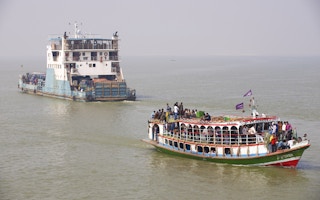The Bangladeshi government has reached out to India in building the Ganges barrage on the Padma river – as the Ganga is known in Bangladesh.
The barrage will be a 165 kilometres long reservoir running from Pangsa Upazila in Rajbari to Pangkha in Chapainawabganj district, with a depth of 12.5 metres. It will hold a phenomenal 2.9 billion cubic litres and cost BDT 314 billion (approximately USD 4 billion).
The barrage will retain the water of the trans-boundary river Ganga, known as the Padma in Bangladesh, during the monsoon and feed small rivers during the lean season. This will reduce salinity, a major threat to public health and agriculture in Bangladesh’s southwest.
The high costs of salinity
Much of Bangladesh’s salinity problem seems to be linked to the Farraka barrage, which went into operation in 1975. The barrage is situated in the Indian state of West Bengal, approximately 30 kilometres upstream of where the Ganga enters Bangladesh.
After the construction of the barrage there was a drop in the river Padma (as the river is known in Bangladesh). As water levels dropped across the southwest of Bangladesh soil salinity increased, including in the Sundarbans, the largest mangrove forest in the world.
Approximately 0.83 million hectares of land were affected by salinity in the coastal area in 1973, two years before the Farakka barrage went into operation. The area has now increased to 1.05 million hectares, covering more than half the coastal land mass in the Ganga floodplain in Bangladesh.
Over 6,200 hectares of farmland (equivalent to 7,140 football fields) are affected on an average annually. In the worst affected areas, the salinity level is 25 parts per thousand or higher – equivalent to 25 grams of salt dissolved in one kilogramme of soil or water.
At such high levels, no crops can grow in the soil. This had a catastrophic effect on agriculture and wildlife, and put the health, livelihood and food security of millions of people in 18 coastal districts in jeopardy.
After the signing of the Ganga Waters treaty between India and Bangladesh in 1996, Bangladesh began receiving water during the extreme dry season, from January to May, but this did not reverse the damage that increasing salinity had done.
Bangladeshi experts have long advocated the building of a Ganges barrage as a complement to the Farakka barrage since the 1960s but work on a feasibility study only began in 2009, and a design was completed in 2014.
Once the project is implemented, the feasibility study says, the soil salinity level in the areas surrounding the south-western rivers, including the Gorai, Modhumati, Chitra, Nabaganga, Chandana, Mathabhanga, Atai, Bhairav, Betna, Kobadak, Sibsa and the Baleswar will reduce significantly in the lean period.
The feasibility study suggests that the annual incremental benefit will be BDT 73.4 billion (USD 0.94 billion), which would mean the barrage would pay for itself within five years. On top of that, nearly a third of the Sundarbans will be converted from a high salinity zone to a low salinity area.
Regional cooperation is a must
Anisul Islam Mahmud, the Bangladeshi minister for water resources, said Dhaka has already sent a proposal to India seeking cooperation. “The Ganga flows through both Bangladesh and India. So, the project would not be successful without India’s cooperation,” the minister said, emphasising that regional cooperation is needed to manage the river basins of transnational water bodies.
It is not yet clear how exactly the countries would work together. They have never worked on any major mega-projects before, although there are increasing efforts to do so. In 2010 the prime ministers of the two countries signed a joint communique when the Bangladeshi Prime Minister, Sheikh Hasina, visited India.
As part of the communiqué, Bangladesh received a USD 1 billion soft loan from India, with a special focus on the development of railways and waterways. In 2012 India and Bangladesh also signed an agreement to jointly build a 1,320 MW coal-fired plant in Bangladesh under the aegis of a joint company called the Bangladesh-India friendship company. Although there have been environmental concerns about the power plant, the Bangladeshi government has said that these fears are overstated and it is committed to pursuing the project.
A role for China?
In this context of increasing joint projects there is particular hope for cooperation in the construction of the Ganges barrage. Although India and Bangladesh share 53 trans-boundary rivers, the Ganga is the only river for which these two South Asian countries have a formal water sharing agreement, which was signed in 1996.
As of now Bangladesh seems to have only asked for Indian help in the actual construction of the project, and it is unclear where the funding will come from.
In 2014, Sheikh Hasina had also travelled to China to discuss soft loans for major infrastructure projects. Interestingly China had also agreed to work on a 1,320 MW coal fired plant in Bangladesh, much like with India.
Depending on how both these issues – that of the Ganges barrage and the power plant – move forward, it is quite possible that India and China may end up cooperating to help Bangladesh deal with its current problems of energy and environment.










